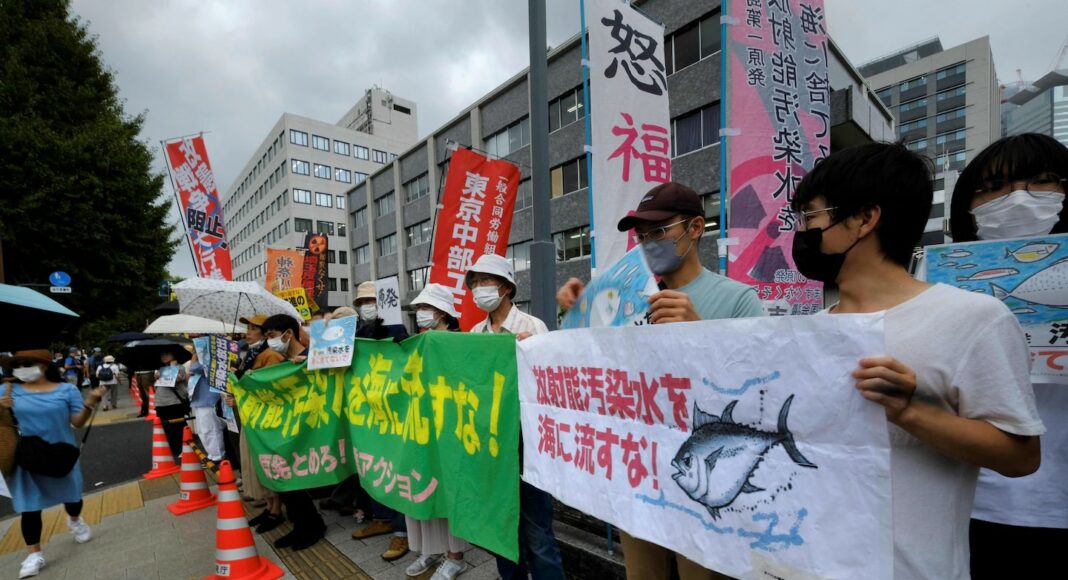Ειδήσεις Ελλάδα
Comment on this storyComment
TOKYO — Japan will start discharging treated radioactive water from the crippled Fukushima Daiichi nuclear plant into the Pacific Ocean as soon as Thursday, despite fierce opposition from neighboring countries and Japan’s fishing industry.
Japanese Prime Minister Fumio Kishida said Tuesday that the release of more than 1 million metric tons of wastewater — equivalent to more than 500 Olympic-size swimming pools — will take place in a safe manner.
“We expect the discharge to begin on Aug. 24 if weather and sea conditions do not hinder it,” Kishida said after a cabinet meeting in Tokyo, asking the plant’s operator, Tokyo Electric Power Co., to prepare for the release.
Japan said it will send treated radioactive water from Fukushima Daiichi nuclear plant into the Pacific Ocean on Aug. 24, despite local and global opposition. (Video: Naomi Schanen/The Washington Post)
After a two-year review, the International Atomic Energy Agency (IAEA) concluded last month that Japan’s plan meets international safety standards and would have “negligible” radiological impact on people and the environment.
“The government is committed to taking full responsibility until the disposal of the treated water is completed, even if it takes decades to complete,” Kishida said Tuesday.
The water, filtered to remove radioactive elements and highly diluted to lower the concentration of tritium, will be released into the Pacific Ocean in a process expected to take more than 30 years. The concentration of tritium, a radioactive material that is extremely difficult to separate from water, will drop to background ocean levels after the dilution, Japanese authorities say.
What to know before Japan releases water from Fukushima nuclear plant
For years, the contaminated water has been stored in large metal tanks near the plant, the site of one of the worst nuclear disasters in history. But Japan is running out of space to build more tanks to accommodate the contaminated groundwater and rainwater that are still exiting the site.
Starting Thursday, the treated water will be discharged at a maximum rate of 132,000 gallons a day through an underwater tunnel off the coast of Japan. External observers, including the IAEA, will monitor the release process.
The IAEA said Tuesday that it will maintain “its impartial, independent, and objective safety review during the discharge phase.” The agency, which has an office at the plant, said it will continue to assess the relevant activities and publish independent data.
Despite such assurances, environmental groups have questioned the safety of releasing the contaminated water and urged Tokyo to drop the plan.
“Instead of engaging in an honest debate about this reality, the Japanese government has opted for a false solution — decades of deliberate radioactive pollution of the marine environment — during a time when the world’s oceans are already facing immense stress and pressures,” said Shaun Burnie, senior nuclear specialist at Greenpeace East Asia.
The pending discharge has been highly politicized by neighboring countries. China has been adamantly opposed to the release, which comes at a time of heightened geopolitical tensions between Tokyo and Beijing.
“China has pointed out on many occasions that ocean discharge is not the safest or most prudent option to dispose of the nuclear-contaminated water. Japan simply chose it to lower economic costs,” Chinese Foreign Ministry spokesman Wang Wenbin said Monday. “This will pose unnecessary risks to neighboring countries and the rest of the world,” he said, urging Japan to call off the plan.
The plan has also ignited debates in South Korea, which has banned seafood imports from the Fukushima area, even though South Korea’s own assessment of the water-release plan also found it meets international standards.
A decade after Fukushima disaster, foes of nuclear power reconsider
A senior South Korean government official said Tuesday that Seoul does not necessarily support Japan’s wastewater plan but sees “no scientific or technical problems.”
“If the actual discharge deviates from the plan, even just a little bit, we will deem it a threat to the safety and health of our people, and immediately ask Japan to stop,” said Park Gu-yeon, vice minister of government policy coordination.
But opposition politicians have raised concerns that South Korean waters may be affected by the release, accusing President Yoon Suk Yeol of overlooking the health risks to mend diplomatic ties with Tokyo.
“The Yoon Suk Yeol administration is turning a blind eye to Japan’s dumping of nuclear-contaminated water into the sea,” said Kang Sun-woo, a spokeswoman for the main opposition Democratic Party.
Fukushima’s fishing and agricultural industries are also worried about potential reputational harm for their products, which still carry the stigma of radioactive exposure.
“Our position has not changed and we continue to be opposed,” Masanobu Sakamoto, head of the National Federation of Fisheries Cooperative Associations, said Monday after meeting with Kishida.
“Our understanding about the safety of the treated water has deepened, but scientific safety and safety from a social point is different. Once the water is released, there will be reputational damage,” he said.
Fishing season in Fukushima is due to start Sept. 1, and the Japanese government has pledged to monitor the water quality and collect data every day following the release.
In Tokyo, about 230 people gathered in front of the prime minister’s office Tuesday to protest the plan, holding signs and chanting slogans such as “Listen to the fishermen” and “The release will impact future generations.”
According to a recent Kyodo News poll, 88.1 percent of respondents expressed concern that the release will hurt Japan’s image abroad. The Japanese government has said it will allocate $200 million to compensate the fishing industry for any reputational impact, and $340 million to mitigate the impact on the local economy.



